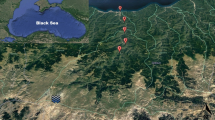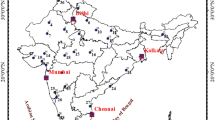Abstract
Obtaining an accurate estimate of the reference evapotranspiration (ETo) can be difficult, especially when there is insufficient data to utilize the Penman–Monteith method. Artificial intelligence–based methods may provide reliable prediction models for several applications in engineering. However, time-series prediction based on artificial neural network (ANN) learning algorithms is fundamentally problematic. For example, the ANN model can experience over-fitting during training and, in consequence, lose its generalization. In this research, several over-fitting procedures have been augmented with the classical ANN model, are proposed. This model was applied to the prediction of the daily ETo at Rasht city, located in the north part of Iran, by using the minimum and maximum daily temperature of the region collected from 1975–1988. In addition, three different scenarios have been developed in order to achieve better prediction accuracy. The results showed that the proposed ENN model successfully predicted the daily ETo with a significant level of accuracy using only the maximum and minimum temperatures. The model also outperformed the classical ANN method. In addition, the proposed ENN compared with Hargreaves and Samani (Appl Eng Agric 1:96–99, 1985) (HGS) model and showed the ENN provides more accurate prediction for ETo. Furthermore, the proposed model could provide relatively good level of accuracy when examined for multi-lead predictions, which could not be afford by HGS model.











Similar content being viewed by others
Abbreviations
- ANN:
-
Artificial neural networks
- R2 :
-
Correlation coefficient
- ENN:
-
Ensemble neural network
- ETo :
-
Reference evapotranspiration
- FFBP:
-
Feed-forward back-propagation
- HGS:
-
Hargreaves and Samani
- IN:
-
Iteration number
- LVC:
-
Low value criteria
- MARE:
-
Mean absolute relative error
- MAE:
-
Mean absolute error
- MSE:
-
Mean square error
- PVC:
-
Peak value criteria
- PM:
-
Penman–Monteith
- Rs :
-
Solar radiation
- Ra :
-
Extraterrestrial radiation
- Tmin :
-
Minimum temperature
- Tmean :
-
Mean temperature
- Tmax :
-
Maximum temperature
References
Adeli H, Hung SL (1995) Machine learning—neural networks, genetic algorithms, and fuzzy systems. Wiley, New York
Adeli H, Vishnubhotla PR (1992) Parallel processing and parallel machines. In: Adeli H (ed) Parallel processing in computational mechanics. Marcel Dekker, New York, pp 1–20
Allen RG, Pereira LS, Raes D, Smith M (1998) Crop evapotranspiration: guidelines for computing crop water requirements. FAO irrigation and drainage paper 56, Food and Agricultural Organization of the United Nations (FAO), Rome. Artificial Neural Network. J Irrig Drain Eng 129(6):454–457
Awchi TA (2008) Application of radial basis function neural networks for reference evapotranspiration prediction. Al-Rafi-dain Eng 16(1):117–129
Birkinshaw SJ, Parkin G, Rao Z (2008) A hybrid neural networks and numerical models approach for predicting groundwater abstraction impacts. J Hydroinformatics 10(2):127–137
Bishop CM (1996) Neural networks for pattern recognition, 1st edn. Oxford University Press, Oxford
Boto-Giralda D, Díaz-Pernas FJ, González-Ortega D, Díez-Higuera JF, Antón-Rodríguez M, Martínez-Zarzuela M, Torre-Díez I (2010) Wavelet-based denoising for traffic volume time series forecasting with self-organizing neural networks. Comput Aided Civil Infrastruct Eng 25(7):530–545
Box GH, Jenkins G (1970) Time series analysis: forecasting and control. San Francisco, Holden-Day
Bulygina N, Gupta H (2010) How Bayesian data assimilation can be used to estimate the mathematical structure of a model. Stoch Environ Res Risk Assess 24:925–937
Chattopadhyay S, Chattopadhyay G (2008) Identification of the best hidden layer size for three layered neural net in predicting monsoon rainfall in India. J Hydroinformatics 10(2):181–188
Chauhan S, Shrivastava RK (2008) Performance evaluation of reference evapotranspiration estimation using climate based methods and artificial neural networks. Water Resour Manag 23:825–837
Chowdhury S, Sharma A (2009) Multisite seasonal forecast of arid river flows using a dynamic model combination approach. Water Resour Res 45(10): art. no. W10428
Clair TA, Ehrman JM (1998) Using neural networks to assess the influence of changing seasonal climates in modifying discharge, dissolved organic carbon, and nitrogen export in eastern Canadian rivers. Water Resour Res 34(3):447–455
Coulibaly P, Anctil F, Bobee B (2000) Daily reservoir inflow forecasting using artificial neural networks with stopped training approach. J Hydrol 230(3–4):244–257
Dibike BY, Coulibaly P (2008) TDNN with logical values for hydrologic modeling in a cold and snowy climate. J Hydroinformatics 10(4):289–300
Drucker H, Cortes C, Jackel D (1994) Boosting and other ensemble methods. Neural Comput 6:1289–1301
El-Shafie A, Abdin AE, Noureldin A, Taha MR (2009) Enhancing inflow forecasting model at Aswan high dam utilizing radial basis neural network and upstream monitoring stations measurements. Water Resour Manag 23(11):2289–2315
El-Shafie AH, El-Shafie A, El Mazoghi HG, Shehata A, Taha MR (2011) Artificial neural network technique for rainfall forecasting applied to Alexandria, Egypt. Int J Phys Sci 6(6):1306–1316
El-Shafie A, Jaafer O, Seyed A (2011) Adaptive neuro-fuzzy inference system based model for rainfall forecasting in Klang River, Malaysia. Int J Phys Sci 6(12):2875-2888
Elshorbagy A, Simonovic SP, Panu US (2000) Performance evaluation of artificial neural networks for runoff prediction. J Hydrol Eng 5(4):424–427
Fernando DA, Jayawardena AW (1998) Runoff forecasting using RBF networks with OLS algorithm. J Hydrol Eng 3(3):203–209
Fooladmand HR (2011) Evaluation of some equations for estimating evapotranspiration in the south of Iran. Arch Agron Soil Sci 57(7):741–752
Gao G, Chong-Yu X, Chen D, Singh VP (2012) Spatial and temporal characteristics of actual evapotranspiration over Haihe River basin in China. Stoch Environ Res Risk Assess 26:655–669
Gibson GJ, Cowan CFN (1990) On the decision regions of multilayer perceptrons. Proc IEEE 78(10):1590–1594
Giustolisi O, Laucelli D (2005) Improving generalization of artificial neural networks in rainfall–runoff modelling / Amélioration de la généralisation de réseaux de neurones artificiels pour la modélisation pluiedébit. Hydrol Sci J 50(3):457
Giustolisi O, Simeone V (2006) Optimal design of artificial neural networks by a multi-objective strategy: groundwater level predictions. Hydrol Sci J 51(3):502–523
Graf W, Freitag S, Kaliske M, Sickert J-U (2010) Recurrent neural networks for uncertain time-dependent structural behavior. Comput Aided Civil Infrastruct Eng 25(5):322–323
Hargreaves GH, Samani ZA (1985) Reference crop evapotranspiration from temperature. Appl Eng Agric 1(2):96–99
Haykin S (1994) Neural networks: A comprehensive foundation. Macmillan College Publishing Company, New York
Hsu K, Gupta HV, Sorooshian S (1995) Artificial neural network modeling of the rainfall-runoff process. Water Resour Res 31(10):2517–2530
IPCC 2007 (2009) Summary for policymakers. In: Solomon S, Qin D, Jain M, Das A, Srivastava DK (eds) Climate change 2007. Application of ANN for reservoir inflow prediction and operation. J Water Resour Plan Manag 125(5):263–271
Jacquin AP, Shamseldin AY (2009) Review of the application of fuzzy inference systems in river flow forecasting. J Hydroinformatics 11(3–4):202–210
Jain SK, Nayak PC, Sudheer KP (2008) Models for estimating evapotranspiration using artificial neural networks, and their physical interpretation. Hydrol Process 22(13):2225–2234
Johnson F, Sharma A (2010) A comparison of australian open water body evaporation trends for current and future climates estimated from class a evaporation pans and general circulation models. J Hydrometeorol 11(1):105–121
Khajehzadeh M, Taha MR, El-Shafie A, Eslami M (2011) Modified particle swarm optimization for optimum design of spread footing and retaining wall. J Zhejiang U:Science A 12(6):415-427
Khoob AR (2008) Comparative study of Hargreaves’s and artificial neural network’s methodologies in estimating reference evapotranspiration in a semiarid environment. Irrig Sci 26(3):253–259
Kisi O (2009) Modeling monthly evaporation using two different neural computing techniques. Irrig Sci 27:417–430
Kumar M, Raghuwanshi NS, Singh R, Wallender WW, Pruitt WO (2002) Estimating evapotranspiration using artificial neural network. J Irrig Drain Eng 128(4):224–233
Liong SY, Khu ST, Chan WT (2001) Derivation of Pareto front with genetic algorithm and neural network. J Hydrol Eng 6(1):52–61
Maier HR, Dandy GC (1999) Empirical comparison of various methods for training feed-forward neural networks for salinity forecasting. Water Resour Res 35(8):2591–2596
Noureldin A, El-Shafie A, Bayoumi M (2011) GPS/INS integration utilizing dynamic neural networks for vehicular navigation. Inf Fusion 12(1):48–57
Odhiambo LO, Yoder RE, Hines JW (2001) Optimization of fuzzy evapotranspiration model through neural training with input-output examples. Trans ASAE 44(6):1625–1633
Rahimi Khoob A, Behbahani MB, Fakheri J (2012) An evaluation of four reference evapotranspiration models in a subtropical climate. Water Resour Manag 26(10):2867–2881
Reuter U, Möller B (2010) Artificial neural networks for forecasting of fuzzy time series. Comput Aided Civil Infrastruct Eng 25(5):363–374
Ripley BD (1996) Pattern recognition and neural networks, Cambridge University Press, New York
Royuela MP, Manzano J, Palau G (2008) Improvement of temperature based ANN models for ETo prediction in coastal locations by means of preliminary models and exogenous data. In: 2008 eighth international conference on hybrid intelligent systems, pp 344-349
Sabziparvar AA, Tabari H (2010) Regional estimation of reference evapotranspiration in arid and semi-arid regions. J Irrig Drain Eng ASCE 136(10):724–731
Samant A, Adeli H (2000) Feature extraction for traffic incident detection using wavelet transform and linear discriminant analysis. Comput Aided Civil Infrastruct Eng 15(4):241–250
Sudheer KP, Gosain AK, Ramasastri KS (2003) Estimating actual evapotranspiration from limited climatic data using neural computing technique. J Irrig Drain Eng 129(3):214–218
Tabari H (2010) Evaluation of reference crop evapotranspiration equations in various climates. Water Resour Manag 24:2311–2337
Tabari H, Grismer ME, Trajkovic S (2011) Comparative analysis of 31 reference evapotranspiration methods under humid conditions. Irrig Sci. doi:10.1007/s00271-011-0295
Tabari H, Martinez C, Ezani A, Hosseinzadeh Talaee P (2012) Applicability of support vector machines and adaptive neurofuzzy inference system for potato crop evapotranspiration forecasting. Irrig Sci. doi:10.1007/s00271-012-0332-6
Telesca L, Vicente-Serrano SM, Lo′pez-Moreno JI (2012) Power spectral characteristics of drought indices in the Ebro river basin at different temporal scales. Stoch Environ Res Risk Assess. doi:10.1007/s00477-012-0651-4
Todorovic B, Stankovic M, Todorovic-Zakula S (2000) Structurally adaptive RBF network in nonstationary time series prediction. In: Proceedings of adaptive systems for signal processing, communication and control symposium, IEEE, New York, pp 224–229
Tokar AS, Johnson PA (1999) Rainfall-runoff modeling using artificial neural networks. J Hydrol Eng 4(3):232–239
Trajkovic S, Todorovic B, Stankovic M (2003) Forecasting of reference evapotranspiration by artificial neural network for modeling reference evapotranspiration complex process in Sudano-Sahelian zone. Agric Water Manag 97(5):707–714
Tsanis IK, Coulibaly P, Daliakopoulos IN (2008) Improving groundwater level forecasting with a feed forward neural network and linearly regressed projected precipitation. J Hydroinformatics 10(4):317–330
Wang YM, Kerh T (2008) Neural network approach for estimating reference evapotranspiration from limited climatic data in Burkina Faso. WSEAS Trans Comput 7(6):704–713
Yang T, Chen X, Xu Chong-Yu, Zhang Z-C (2009) Spatio-temporal changes of hydrological processes and underlying driving forces in Guizhou region, Southwest China. Stoch Environ Res Risk Assess 23:1071–1087
Zanetti SS, Sousa EF, Oliveira VPS, Almeida FT, Bernardo S (2007) Estimating evapotranspiration using artificial neural network and minimum climatological data. J Irrig Drain Eng 133(2):83–89
Zamani A, Heemink A, Solomatine D (2009) Wave height prediction at the Caspian Sea using a data driven model and ensemble-based data assimilation methods. J Hydroinformatics 11(2):154–164
Zhang Q, Chong-Yu X, Chen YD, Ren L (2011) Comparison of evapotranspiration variations between the Yellow River and Pearl River basin, China. Stoch Environ Res Risk Assess 25:139–150
Acknowledgments
This research is supported by a research grants to the first author by Smart Engineering System, and Water and Environmental Research Group, University Kebangsaan Malaysia; UKM-GUP-2011-034, UKM-DLP-2011-002 and FRGS/1/2012/TK03/UKM/02/4.
Author information
Authors and Affiliations
Corresponding author
Rights and permissions
About this article
Cite this article
El-Shafie, A., Alsulami, H.M., Jahanbani, H. et al. Multi-lead ahead prediction model of reference evapotranspiration utilizing ANN with ensemble procedure. Stoch Environ Res Risk Assess 27, 1423–1440 (2013). https://doi.org/10.1007/s00477-012-0678-6
Published:
Issue Date:
DOI: https://doi.org/10.1007/s00477-012-0678-6




